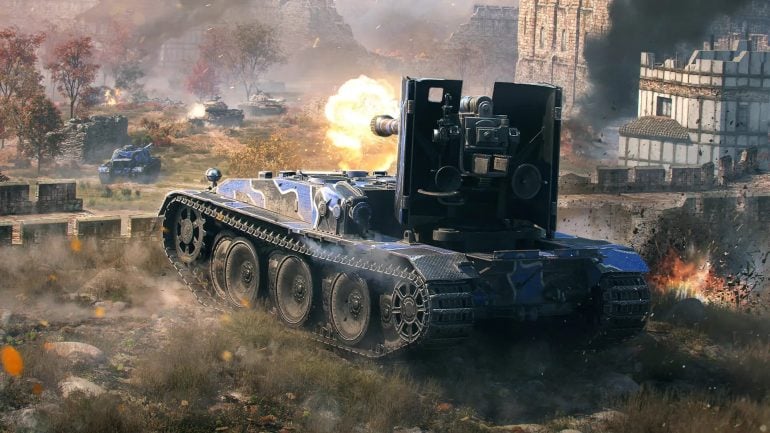No tank is invincible. No matter how well-protected your mobile bunker may feel, there will always be chinks in its armor — weak spots that a clever (or lucky) opponent can use to destroy you. Learning how to exploit and protect weak spots is essential knowledge for any player looking to elevate their skill level in World of Tanks. This is especially true at the higher tiers, where almost everyone knows the common weak points.
In this guide, we’ll go over weak spots and how they affect gameplay. We’ll also cover a few of the most common World of Tanks weak spots, so you know what to look for in your next match.
Elevate your gameplay with exclusive perks! Dive into the world of World of Tanks codes and conquer the seas with World of Warships codes now.
Common tank weak spots
No two tank types are the same, but they do mostly share similar weak points. In this section, we’ll go over some of the most common tank weak spots.
Front weak spots
Most tank types are designed to attack while charging forward. So, while each tank has its own armor configuration with unique weak points, they all generally have their thickest armor on the front. That doesn’t mean there aren’t spots you can exploit when attacking the front side of an enemy; it just means they’re fewer and harder to hit.
The driver’s visor is the tiny section on the frontal plate that the driver uses to see where they’re going. This is very hard to hit from anywhere but close range.
Aiming for the turret hatch can damage crew members and affect the enemy’s spotting range. This is tough to hit from a distance but should be a priority target when coming in close.
The lower glacis is a favorite weak spot for mid-range fighters. The glacis is the sloped front-side of the hull, and just below that is a relatively large block between the tracks that’s vulnerable to a precise shot.
The turret ring is the section just below the turret that connects the main gun to the body of the tank. If you hit this, not only will you do serious damage, but you’ll also severely reduce the traversal rate of their primary gun. It’s notoriously hard to hit, though, as it sits in a tiny section just below the main turret.
Side weak spots
You’ll want to try to fire at the enemy from their sides for multiple reasons. First, the sides of a tank have thinner armor than the front, so your shells have a greater chance at penetrating the hull. The second reason is the side profile of a tank is much larger than the front or rear, making for an easier target. Lastly, many of a tank’s modules are found on its sides; a good shot can drastically reduce their combat effectiveness.
The most obvious side weak spot are the tracks. A tank needs these to even move, so dealing enough damage to them will make them sitting ducks for your allies to obliterate.
Whenever possible, aim for the wheel in the front or in the one in the back. These are the track idler and main drive sprocket, and they help drive the tank. Destroying these will completely immobilize your opponent.
Rear weak spots
A tank’s rear is usually the most lightly armored part of the tank. In most cases, it doesn’t matter where you first, there’s a good chance you’ll penetrate the hull.
In some tanks, the rear is where the engine is located, so you can even do some engine damage at the same time. Switch to HE shells to improve your odds of setting the target on fire (for a detailed explanation why, read our guide on when to use HE rounds in World of Tanks).
You won’t often find yourself facing an enemy tank’s rear. Most players know to position their tanks to at least prevent backside attacks. So, if you’re ever fortunate enough to be able to attack someone from the back, take full advantage!
Protecting your own weak spots
Sometimes we get so caught up in optimizing fire and watching for vulnerable weak spots that we leave ourselves open for an easy shot. Remember: your own tank has weak spots, too!
Learning how to properly use camo can go a long way to improving your battlefield survival rate, but at some point, you’ll have to study your own tank.
Ask yourself these questions:
- Where is my tank’s armor the thinnest?
- What terrain and cover are available at this firing spot?
- From which angles am I exposed?
The answer to the first question will take a bit of internet sleuthing, but the last two are questions you should be constantly asking yourself in battle. Train yourself to always consider the potential risks and rewards of any situation. This is much easier said than done, but with practice and knowledge, it will become second nature.
At some point, every World of Tanks player comes to realize the importance of understanding weak spots. In a war simulator like this, understanding the systems and how to exploit them is half the battle. Hopefully, this guide has shed some light on why weak points matter.
Depending on how seriously you want to play World of Tanks, you may not want to bother with studying armor thicknesses of every tank. Just knowing common weak spots, both on the enemy and your own tank, will go a long way to making you a better, more strategic player.
Can’t get enough war games? Read our picks of the best war games. Or have fun without spending a dime with the best free PC games available.

